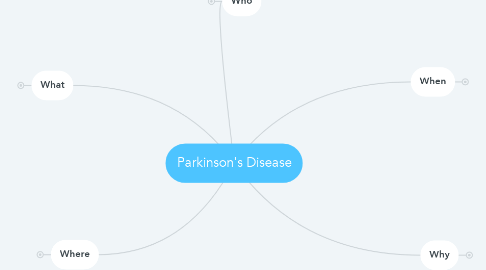
1. Who
1.1. 1 million in US
1.1.1. 2nd most common neurodegenerative disease
1.2. Men>Women
1.3. 2% of people >65 years
1.4. Average onset 50-60 years
1.4.1. Young: 21-50 years
1.4.2. Juvenile: <21 years
2. What
2.1. Progressive disease of CNS
2.2. Medical Diagnosis
2.2.1. Bradykinesia
2.2.1.1. Due to insufficient force production when initiating movement
2.2.1.2. Associated Symptoms
2.2.1.2.1. Bradyphrenia
2.2.1.2.2. Akinesia
2.2.1.2.3. Hypomimia
2.2.1.2.4. Hypokinesia
2.2.1.3. Muscle activity
2.2.1.3.1. Fragmented activation
2.2.1.3.2. Multiple short bursts rather than sustained contraction
2.2.2. One of the following
2.2.2.1. 4-6 Hz Resting Tremor
2.2.2.1.1. Decreases during movement
2.2.2.1.2. Not present during sleep
2.2.2.1.3. Aggravated by stress
2.2.2.2. Rigidity
2.2.2.2.1. Cogwheel vs Leadpipe
2.2.2.2.2. Proximal to distal progression
2.2.2.2.3. Exacerbated by stress, movement, concentration
2.2.2.2.4. Tone levels greatest to least
2.2.2.3. Postural Instability
2.2.2.3.1. Can't be caused by primary visual, vestibular, cerebellar, or proprioceptive dysfunction
2.2.2.3.2. Smaller BOS
2.2.2.3.3. Slow APAs
2.2.2.3.4. APR defecits
2.3. Non-motor symptoms
2.3.1. Anosmia
2.3.2. Constipation
2.3.3. REM sleep issues
2.3.4. Depression
2.3.5. Anxiety
2.3.6. Orthostatic hypotension
2.3.7. Unilateral limb pain
2.3.8. Erectile dysfunction
2.3.9. Bladder dysfunction
2.3.10. Apathy
2.3.11. Attention problems
2.3.12. Excessive salivation
2.3.13. Daytime sleepiness
2.3.14. Skin changes
3. When
3.1. Stages of Severity
3.1.1. 1
3.1.1.1. Unilateral involvement only
3.1.2. 1.5
3.1.2.1. Unilateral + axial involvement
3.1.3. 2
3.1.3.1. Bilateral symptoms; NO impairment of balance
3.1.4. 2.5
3.1.4.1. Mild bilateral disease with recovery on pull test
3.1.5. 3
3.1.5.1. Mild to moderate disease; Physically independent
3.1.6. 4
3.1.6.1. Severe disability BUT still able to walk or stand unassisted
3.1.7. 5
3.1.7.1. Wheelchair-bound or bedridden unless assisted
3.2. Braak Stages
3.2.1. 1 & 2
3.2.1.1. Autonomic and olfactory disturbances
3.2.2. 3 & 4
3.2.2.1. Sleep and motor disturbances
3.2.3. 5 & 6
3.2.3.1. Emotional and cognitive disturbances
4. Where
4.1. Basal Ganglia
4.1.1. Substantia
4.2. Vagus Nerve
4.2.1. Constipation
4.3. Olfactory Bulb
4.3.1. Loss of smell
4.4. Diencephalon and Brainstem
4.4.1. Sleep and motor disturbances
4.5. Limbic system
4.5.1. Emotional disturbances
4.6. Prefrontal cortex
4.6.1. Cognitive distrubances
5. Why
5.1. Degeneration of dopamine-producing neurons in the substantia nigra
5.2. Secondary PD
5.2.1. Toxic Parkinsonism
5.2.1.1. Environmental toxin exposure
5.2.1.1.1. Pesticides
5.2.1.1.2. Industrial Chemicals
5.2.1.1.3. MPTP
5.2.2. Drug-induced Parkinsonism
5.2.2.1. Neuroleptics
5.2.2.2. Anti-depressants
5.2.2.3. Anti-hypertensives
5.2.3. Additional causes
5.2.3.1. Calcium metabolism disorders
5.2.3.2. Hypothyroidism
5.2.3.3. Hyperparathyroidism
5.2.3.4. Hypoparathyroidism
5.2.3.5. Wilson's Disease

